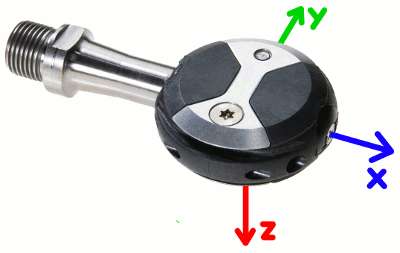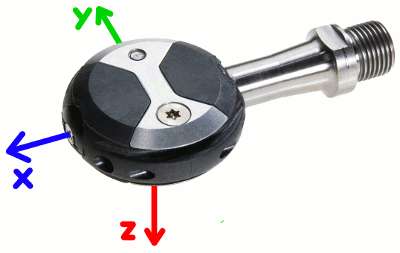MetriGear Vector Pt 2: Coordinates Defined
As I noted last post, the MetriGear Vector ("Direct your forces") is targeted as much as a force meter as a power meter. Get force right, get velocity right, and you get power right.
Power associated with mechanical work equals the product of a velocity magnitude ("speed") and the component of force applied in the direction of that velocity. This is equal to the vector dot-product of velocity and force. Virtually every power meter deals with this relationship. For example, the iBike estimates the forces acting on the bicycle, then multiplies those forces times the measured speed of the bike. The Polar power meter estimates the tension (force) in the chain, and multiplies it by the speed of the chain. The SRM and Quarq Cinqos measure the torque (an integral of force times distance) in the crank spider and multiples it by a rotational velocity (a speed divided by a radius). The PowerTap does a similar calculation, measuring a torque in the hub and multiplying by a rotational velicity of the hub. So generally all existing "power meters" are force based.
Where the Vector differs from these other units, however, is that it is measuring multiple forces components, not just one in a single direction. These other units are essentially measuring a single force (or torque). The PowerTap, for example, will record and report hub torque, but except for calibration purposes that number isn't of much independent interest from the power number (except at zero speed, where power is automatically zero and thus provides no information).
To consider the force components on a pedal, I'll define coordinate axes:

Axes for right pedal
A few comments on this:
For the left pedal, taking the mirror image of the schematic for the right pedal, results in a right-handed coordinate system:

Axes for left pedal
it would have been more appropriate for the right pedal to have a right-handed coordinate system, and the left to have a left, but these coordinates (to me) make more sense.
For this analysis I'll assume the right pedal is at 3 o'clock (pointing forward), the left pedal at 9 o'clock (pointing backward). There's no loss of generality here; it just avoids complexity in the math. I'll further assume the bike is on rollers or another form of stationary trainer. Thus the pedals are turning in circles relative to the intertial coordinate systems, but not translating through those coordinates.
This last assumption is worth discussing a bit. If the bike is moving forward, then the motion of the pedal consists of two components: a translational component (moving with the rest of the bike) and a rotational component (spinning about the hub axis). As I mentioned, power equals force in the direction of a velocity times the magnitude of that velocity. Suppose the bike is coasting forward and I'm pushing forward on both pedals but not spinning them. Is this propulsive? Does it contribute to bike motion? Well, probably not. If both feet are pushing forward, then Newton's third law (for every reaction there is an equal and opposite reaction) suggests there needs to be something else pushing backwards. Unless the rider is pushing against the ground with his foot, then this "opposite" force will be against either the saddle or the handlebars. Since I don't have Vectors in my seat post or stem, I won't be measuring these components of power. But I can generally rely on Newton's law that pulling on the handlebars while pushing on the pedals will not move the bike forward. So the only pedal velocity I'm interested in is the rotational velocity: the velocity of the pedals rotating about the hub. This is why I choose to have my coordinate axes in the frame of the bicycle, rather than the frame of the ground. These coincide if the bike is on a trainer, which is the case I'll assume.
Okay, enough of all of that. I'll continue with this next time...
Power associated with mechanical work equals the product of a velocity magnitude ("speed") and the component of force applied in the direction of that velocity. This is equal to the vector dot-product of velocity and force. Virtually every power meter deals with this relationship. For example, the iBike estimates the forces acting on the bicycle, then multiplies those forces times the measured speed of the bike. The Polar power meter estimates the tension (force) in the chain, and multiplies it by the speed of the chain. The SRM and Quarq Cinqos measure the torque (an integral of force times distance) in the crank spider and multiples it by a rotational velocity (a speed divided by a radius). The PowerTap does a similar calculation, measuring a torque in the hub and multiplying by a rotational velicity of the hub. So generally all existing "power meters" are force based.
Where the Vector differs from these other units, however, is that it is measuring multiple forces components, not just one in a single direction. These other units are essentially measuring a single force (or torque). The PowerTap, for example, will record and report hub torque, but except for calibration purposes that number isn't of much independent interest from the power number (except at zero speed, where power is automatically zero and thus provides no information).
To consider the force components on a pedal, I'll define coordinate axes:

Axes for right pedal
A few comments on this:
- the coordinate axes are relative to the spindle relative to the direction of motion of the pedal as it rotates. The angle of the pedal body is irrelevant. The Vector sits in the spindle, not the body, so the body of the pedal is effectively (from the perspective of the Vector) part of the shoe.
- The coordinates shown here for the right pedal are actually a left-handed coordinate system. There's no problem with left-handed coordinate systems (relative to the more conventional right-handed coordinate systems) as long as one is self-consistent.
For the left pedal, taking the mirror image of the schematic for the right pedal, results in a right-handed coordinate system:

Axes for left pedal
it would have been more appropriate for the right pedal to have a right-handed coordinate system, and the left to have a left, but these coordinates (to me) make more sense.
For this analysis I'll assume the right pedal is at 3 o'clock (pointing forward), the left pedal at 9 o'clock (pointing backward). There's no loss of generality here; it just avoids complexity in the math. I'll further assume the bike is on rollers or another form of stationary trainer. Thus the pedals are turning in circles relative to the intertial coordinate systems, but not translating through those coordinates.
This last assumption is worth discussing a bit. If the bike is moving forward, then the motion of the pedal consists of two components: a translational component (moving with the rest of the bike) and a rotational component (spinning about the hub axis). As I mentioned, power equals force in the direction of a velocity times the magnitude of that velocity. Suppose the bike is coasting forward and I'm pushing forward on both pedals but not spinning them. Is this propulsive? Does it contribute to bike motion? Well, probably not. If both feet are pushing forward, then Newton's third law (for every reaction there is an equal and opposite reaction) suggests there needs to be something else pushing backwards. Unless the rider is pushing against the ground with his foot, then this "opposite" force will be against either the saddle or the handlebars. Since I don't have Vectors in my seat post or stem, I won't be measuring these components of power. But I can generally rely on Newton's law that pulling on the handlebars while pushing on the pedals will not move the bike forward. So the only pedal velocity I'm interested in is the rotational velocity: the velocity of the pedals rotating about the hub. This is why I choose to have my coordinate axes in the frame of the bicycle, rather than the frame of the ground. These coincide if the bike is on a trainer, which is the case I'll assume.
Okay, enough of all of that. I'll continue with this next time...

Comments